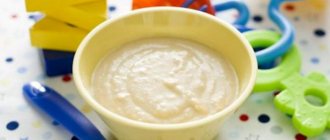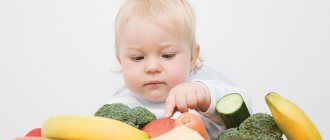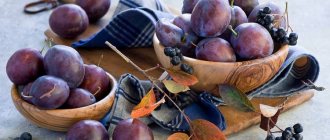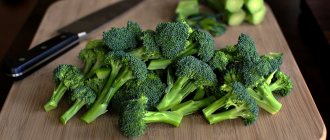In the first year of life, the baby's development progresses by leaps and bounds. The child is actively gaining weight, growing and getting stronger every day. Infant nutrition plays an important role in this. The menu of a breastfed baby at 11 months is no longer as monotonous as, for example, at 5 months. The child's body has already become familiar with many categories of products, but there are still some ingredients that are unacceptable for feeding an 11-month-old baby.
At 11 months, even with breastfeeding, the child’s menu becomes more complex, more varied and closer to the parent’s, “adult”.
What's special about the diet of an 11 month old baby?
By modern standards, 11 months is the period when the child has not yet been weaned from the mother’s breast, but is already eating “adult food” with all his might. Mother's milk alone is no longer enough for the baby; with its help, he saturates the body with essential microelements and vitamins. And a healthy appetite at this age is satisfied by porridge, meat dishes, soups, vegetables and fruits, that is, ordinary food that the baby has already tried. Breast milk acts more as a sedative before bed, protects the child’s body from disease and prevents the development of caries. During the day, breastfeeding is practically absent; doctors also recommend breastfeeding an 11-month-old baby only in the morning or evening. Breakfast, lunch and dinner are already replaced by dishes close to the common table, from products allowed for babies, but still prepared separately. It can be:
- Boiled, stewed and steamed vegetables, fish and meat products. There is no longer any need to grind food into a mushy state - the baby has teeth, he must chew and process pieces of food. The only thing is that you can grind the meat not too much, since it is still difficult for a child to chew hard fibers.
- At the age of 11 months, sugar, salt or herbs can already be added to food. But in small quantities, to the taste of an adult, all dishes for infants still seem unsalted.
- During this period, raw vegetables and fruits are introduced into the child’s diet. Depending on the selected ingredient, you can grate the fruit on a coarse or medium grater. So hard fruits, for example, a carrot or a fresh apple, can be chopped even on a fine grater, and a soft and ripe peach can be chopped on a coarse grater.
- Healthy and mandatory porridges for an eleven-month-old baby’s menu are prepared with milk. This will give the dish more beneficial properties and significantly improve the taste.
11 months is the time when the baby can already eat many ingredients and the mother can combine several familiar foods into one dish. That is, you can already select multi-ingredient recipes and prepare delicious food. For example, dilute the usual cottage cheese with fruit.
Every day the baby looks at this world more and more consciously and learns more and more new things. The mother should be patient and formulate correct eating behavior in the child.
Features of a child's diet
The list of allowed foods at 11 months is quite diverse, so mothers have the opportunity to get creative in the kitchen and show off their culinary skills.
- Vegetables. Vegetables are the foods with which a child begins to feed their complementary foods. At this age, the mother cooks soups and stews for the baby based on them, prepares purees, adds them to porridge, mixes them with meat, fish, and squeezes out the juice. Here are the vegetables a baby eats at 11 months: zucchini, cabbage (cauliflower, Brussels sprouts, broccoli), carrots, onions, potatoes, pumpkin, beets, green peas, asparagus. At this age, he can eat fresh vegetables (with the peel removed), chopped on a coarse grater and seasoned with sunflower oil and sour cream. A little finely chopped greens (dill, parsley) are also added to this vitamin salad. You can introduce white cabbage to your baby at 12 months of age. Start giving it with a minimum amount and only in boiled form. You can add cabbage to soups, stews, purees, and cutlets. Many pediatricians recommend starting to feed your baby eggplants. However, you should be careful here because this vegetable contains solanine. To reduce its amount, the blue ones need to be soaked in salted water before processing. It is imperative to peel the peel so that the baby does not choke while eating. Eggplants are included in soups, stews and vegetable purees. Children with allergies and those who have problems with the digestive tract should not eat blue ones yet.
- Fruits. Fruits are the main source of vitamins and microelements necessary for a growing body. At 12 months of life, the baby has already become acquainted with many fruits. 11 months is the age when you can introduce your child to pomegranate and citrus fruits. It is better to give preference at the initial stage to tangerines, grapefruit and orange. You need to start with a small slice. If no unwanted reactions are observed, let the baby taste pomegranate, orange, and tangerine juices. They should be diluted with water in a ratio of 1:3. After this, you can add other fruit juices (apple, pear, peach) to the drinks. Salads, compotes, jelly are prepared on the basis of fruits, they are mixed with cottage cheese and porridge.
- Meat. The menu of a bottle-fed child, as well as a natural-fed child, already includes turkey, rabbit, veal, beef, horse meat, lean chicken and pork. At this stage, the baby can already be safely introduced to the liver, heart and tongue. Meat puree is added to soups, porridges, and vegetable purees. Meatballs, cutlets, meatballs, dumplings are cooked on its basis, and a delicate soufflé is made. It is recommended to steam and stew meat. Frying and baking are excluded at this age. It is forbidden to offer your baby sausages, sausages, or lard.
- Fish. Only low-fat fish should be included in the menu of a breastfed child, as well as a bottle-fed one. These are pollock, flounder, hake, pike perch, cod, and sea bass. It is better to hold off on semi-fat and fatty varieties, although according to some recommendations, such fish can also be introduced into the diet in small quantities. Processing of fish should only be done by steam. Preference should be given to fresh fish. Fish-based dishes are still served twice a week. On other days, it is recommended to offer your baby meat. You can make cutlets, quenelles, soufflés from fish, add them to soups, and vegetable purees.
- Fermented milk products. Fermented milk products contain bacteria beneficial to the intestinal microflora, which contribute to the smooth functioning of the digestive system. Therefore, such products must be included in the baby’s diet every day. Fermented milk products should not replace full feeding. Kefir, yogurt, cottage cheese are served only in addition to main dishes. At 11 months, you can safely introduce your child to sour cream. You can add the product to vegetable salads, flavor soups, borscht, pour it over meatballs, cutlets, add to casseroles, etc. Yogurt, sour cream and cottage cheese can be mixed with fruits and berries. It is best served for breakfast and during the fourth meal. An important condition is that the baby consumes fermented milk products, prepared independently or purchased in the children's kitchen.
- Berries. Berries must be included in a child’s diet at 12 months of age. The main condition is to eat only seasonal berries. At this age, the baby has already tried: gooseberries, currants (black, yellow, red). Some pediatricians recommend expanding your baby's diet and introducing him to watermelon, strawberries, cherries, cherries and raspberries (if, of course, you are confident in the quality and freshness of the berries). Just be sure to monitor the baby’s reaction. Your baby will definitely love berries if you add them to cottage cheese or porridge. As for fruit drink, before serving it should be diluted with water in a ratio of 1:3.
- Beverages. During the day, the baby must drink clean water. To avoid anemia and vitamin deficiency, the baby needs to drink juices based on fruits and berries, compotes, including dried apricots, prunes, raisins, as well as jelly, fruit drinks, and children's herbal teas. Under no circumstances should a child aged 11 months be given black tea, store-bought juices, drinks sweetened with sugar or honey. This can significantly harm the baby's health.
- Porridge. Porridges at 11 months are given a wide variety - at the discretion of the mother and depending on the taste preferences of the child. Porridges are cooked in water, mother's milk, or artificial formula. At the end you can add a piece of butter. The baby will really like it if you put berries or pieces of fruit in the porridge.
What else can you give a child at 11 months?
Here is a list of foods that also need to be included in the diet of an 11-month-old baby.
- Yolk . Serve the yolk (preferably from quail eggs) no more than 2 times a week.
- Crackers with raisins, cookies. May be served daily.
- Oils. Butter and vegetable oils, mechanically pressed olive oil. Served every day.
- Greenery. Dill, parsley, celery. Added to soups, salads, meat and fish dishes. May be served daily.
What else should an 11 month old baby not eat?
Despite the intensive development of the baby, its digestive system is not yet ready to consume “adult” heavy food. Therefore, the following is excluded from the diet of infants at this age:
- ingredients with a high fat content or fried foods;
- sausage, smoked, dried meat;
- vegetable crops and fruits from exotic countries;
- fatty fish and the same meat;
- products that are a potential source of allergies (honey, chocolate, citrus fruits, some seasonal berries, nuts);
- milk;
- sweet products from the store - they contain dyes, preservatives, and other chemical additives that are not necessary for an 11-month-old child.
How to diversify your diet?
An 11-month-old baby’s taste preferences will constantly change, because he is an individual personality, with his own desires and needs. A caring mother should be able to adapt to her child, and be ready at any time to change her child’s diet at 11 months or at another age and diversify it.
The baby’s daily menu includes products intended only for children, as well as food from the adult table. For example, children's cookies are sold on store shelves, which a mother can give to her child without fear of him choking. Also, the diet of an eleven-month-old baby should include fermented milk products, vegetable and fruit dishes, meat and fish preparations. The menu should include healthy foods that are enriched with vitamins.
Cottage cheese and dairy products
At 11 months, the baby is given cottage cheese in the dairy kitchen. Cottage cheese sold in stores is not recommended to be given to a baby before one year of age, as it contains casein, which is harmful to children. The maximum amount of cottage cheese per day will be no more than 50 grams.
It is also recommended to give your child butter; it has a beneficial effect on digestion.
Meat
Meat is the most important ingredient in the menu of an 11-month-old baby, as it supplies the body with healthy protein. The meat should be lean. Low-fat varieties include: turkey, rabbit, veal, chicken. The meat is used to prepare meatballs, cutlets, and meat puree, which is added to other dishes.
Important! Meat should not be served fried!
Fish
Fish is a source of phosphorus, necessary during bone growth. River fish will do. Before cooking, you must carefully remove the bones from the fish. Serve to your child stewed or boiled. Fish is added to other dishes.
Amount of food for a breastfed baby at 11 months of age
Many pediatricians in their recommendations try to adhere to the WHO recommended amounts of food that are acceptable for a child at this age. The calculation of allowed ingredients per day looks something like this:
- A child should consume about 500 g of breast milk.
- The daily portion of porridge is 200 g.
- Fruit juices complete the 100 g menu.
- Vegetables are about 200 g.
- Meat or fish ingredients - no more than 70-75 g.
- A piece of bread - 10 g.
- The assortment of fruits is present in the amount of 110 g.
- Vegetable oil added during cooking - only 5-6 g.
- Cottage cheese - 50 g per day.
- You are allowed to drink up to 350 g of kefir.
- You can eat only 20 g of cookies.
- Butter - 5-6 g.
When feeding an 11-month-old baby, you should adhere to the recommended amounts of certain foods, as well as fluid intake.
How to correctly calculate how much fluid a baby needs
The required proportions depend on the parameters of each individual baby. The standard calculation formula is that you need 50 ml of drink per kg of weight. For example, if an eleven-month-old baby weighs 10 kg, then the volume of the recommended liquid should be 500 ml. Since babies almost always drink with food, the resulting volume is divided by the number of feedings. It turns out that if a child eats four times, then he should drink a little more than 100 ml at one time. Moreover, this volume includes not only water, but also the first liquid dish (soup), compotes, weak tea or juices. At a certain period of time, for example, in the heat or, conversely, in winter, in a stuffy apartment, the amount of drinking is increased by an average of 15 percent.
What to do if your child is not eating well
There can be many reasons for a child’s poor appetite - a recent illness, ignoring the baby’s taste preferences, coercion during feeding, irregularities in the daily routine, snacking between main meals, teething. All of these factors must be considered by parents. What can be done?
- If a child refuses pumpkin soup or doesn’t like meat cutlets at all, then this is not a reason to force him to empty the plate. The baby may develop an aversion to food. Then it will be very difficult to instill a love for adult food.
- Poor appetite can also be due to snacking. You should not give your baby cookies or crackers before the main meal. This may affect the baby's appetite.
- It is very important for a good appetite to follow a daily routine. If you stick to the same schedule every day, your child will develop a need to eat at the right time.
- Try to take into account the child’s preferences, include different foods in the menu, prepare new dishes, make them beautiful, then the baby’s appetite will noticeably improve.
Video of what to feed a baby at 11 months
Sample menu for one day for an 11 month old baby
At the age of 11 months, it is recommended to feed the baby five times a day. But it is possible that a child can eat both less often and more often, because all children are different. It all depends on the individual characteristics of the baby. An approximate daily diet looks like this:
Breakfast
Breastfed babies tend to wake up quite early, and to set your baby up for a positive morning, you can leave breast milk for feeding after waking up.
Late breakfast
During the second breakfast, the food should be nutritious, this is a complete meal - milk porridge or cooked in water. You can use store-bought mixtures of cereals, grind ready-made porridge, or slightly chop the cereal when cooking. You can add yolk to the dish and wash it down with juice, for example, apple juice.
Dinner
During lunch hours, the child is given the largest amount of food. And it’s better to use as many different products as possible when preparing lunch. This could be: vegetable puree with the addition of butter (butter or vegetable); a portion of white fish or meat - rabbit, turkey or veal; slice of bread; some fruit puree.
Dinner
In the evening, dishes are less voluminous, but nutritious - kefir or cottage cheese mixed with chopped fruit.
Second dinner
Before going to bed, it is better to calm and warm the baby with maternal warmth and give the breast. You can also offer kefir; in any case, you should not feed your baby heavily at night. The body should rest, and the child should sleep sweetly.
According to the baby's needs, at night the mother can breastfeed the baby and put her back to sleep.
The approximate diet of a child at 11 months is varied, nutritious and meets the needs of a child at this age.
Sample menu
Each mother makes a menu for her 11-month-old child on her own:
- 6-7 am: breastfeeding or formula feeding.
- Breakfast at 10-11 o'clock: porridge from oatmeal, rice, buckwheat, corn and other cereals. Butter is added to the porridge. To make the porridge tastier, add berries or fruits (which the baby has already tried before and which did not cause an allergic reaction). They also offer the baby something made from fermented milk for breakfast.
- Lunch is prepared at 2-3 p.m. For lunch, the child is served vegetable soups and purees. You can offer meat dishes in the form of steamed cutlets or meatballs.
- 18-19 hours – dinner. For dinner, the baby is offered to eat children's cookies with yogurt or kefir. They also offer porridge or fruit puree.
- Before the night's rest, at approximately 22:00, the baby is given breastfeeding or formula feeding.
This is a sample menu, but not required. Each mother decides for herself what to offer her child, the main thing is that the diet is balanced and fortified.
When breastfeeding
The menu of an 11-month-old child receiving breast milk should be as follows:
- Early morning - breastfeeding.
- Breakfast - porridge, cooked in milk or half with water, seasoned with butter. Drinks include fruit juice.
- Lunch – vegetable soup or puree, some kind of meat dish.
- Dinner - fruit puree, children's cookies, fermented milk products.
- Eating before bed - breastfeeding.
With artificial feeding
An approximate menu for eleven-month-old children who are bottle-fed is not much different from the menu for an infant. At an earlier age, the nutrition of infants and artificially raised infants may differ significantly, because Children who are breastfed begin to introduce complementary foods later. By the age of 11 months, the nutrition of both is leveled out, and many foods have already been introduced into the diet.
Approximate diet for artificial animals:
- after waking up, the baby is offered milk formula;
- for breakfast - porridge from any cereal, fruit puree, juice;
- lunch - soups or pureed vegetables, meat dishes, fish dishes are recommended to be given no more than 2 times a week, washed down with juice or fruit compote;
- dinner – fermented milk products, fruit purees;
- at night - mixture.
Making a menu for the week - table
The table below shows an approximate menu for a child of 11 months, taking into account that the very first and last feeding will be breastfeeding or formula.
| Day of the week | Eating | Menu |
| Monday | Breakfast | Buckwheat porridge, cottage cheese with the addition of sour cream and pieces of fruit, such as kiwi. Pear juice. |
| Dinner | Vegetable soup with the addition of cauliflower, carrots, zucchini. Chicken cutlets with mashed potatoes. A piece of wheat bread. Dried fruits compote. | |
| Dinner | Rice porridge with banana added. Apple juice or compote. Children's cookies. | |
| Tuesday | Breakfast | Semolina porridge. Cottage cheese + currant berries. Apple jelly. |
| Dinner | Vegetable puree from zucchini, cauliflower. Chicken meatballs with the addition of carrots, onions, rice, seasoned with sour cream. A piece of bread. Egg yolk. Pear juice. | |
| Dinner | Rice porridge with pumpkin. Children's cookies. Cherry juice. | |
| Wednesday | Breakfast | Rice porridge. Cottage cheese with the addition of currants, raspberries, or bananas. Dried fruits compote. |
| Dinner | Vegetable soup with potatoes, carrots, onions, herbs, add vegetable oil. Zucchini puree with added chicken liver. Plum, apple or strawberry compote. | |
| Dinner | Corn porridge. Plum puree. Yogurt. Pear jelly. | |
| Thursday | Breakfast | Wheat porridge. Cottage cheese with pieces of banana, pear or peach. Tangerine juice. |
| Dinner | Borsch. Fish cutlets (hake fish is used) with rice. Vegetable puree from broccoli. Bread. Apple juice. | |
| Dinner | Buckwheat porridge. Kefir. | |
| Friday | Breakfast | Corn grits porridge. Cottage cheese. Plum puree. Apple-pear compote. |
| Dinner | Vegetable puree from broccoli, pumpkin or zucchini. Turkey meatballs with vegetables and rice. ¼ egg yolk. Slice of bread. Banana fruit puree. Orange juice. | |
| Dinner | Rice porridge. Kissel from plums and pears. | |
| Saturday | Breakfast | Oatmeal porridge. Cottage cheese with added fruit puree. Cherry juice. |
| Dinner | Vegetable stew: carrots, zucchini, cauliflower, broccoli. Chicken quenelles. A piece of bread. Apple-cherry juice. | |
| Dinner | Corn porridge. Plum and peaches puree. Fruit compote of apples, cherries and currants. | |
| Sunday | Breakfast | Buckwheat porridge. Cottage cheese with the addition of apricot pieces. Apple juice. |
| Dinner | Vegetable soup seasoned with vegetable oil. Boiled fish, added to vegetable puree. Bread. Juice from apples and pears. | |
| Dinner | Oatmeal. Currant juice. |
This is a sample menu for a week for an 11 month old baby. All products must be enriched with vitamins that the child needs during active growth.
What recommendations should you follow when feeding an 11 month old baby?
- By this period of life, the baby can more or less show a reaction to certain ingredients, so when feeding you need to pay attention to the child’s behavior. If the baby does not like some type of cereal or root vegetable, there is no need to force-feed it, it is worth removing the product from the diet, and later, after a couple of months, try again.
- Every week you can introduce a new ingredient, but only one. And it should be given gradually, starting with a minimum portion - one teaspoon. Then observe his reaction, possible manifestations of allergies, and if the reaction is positive, increase the portion after a few days.
- In order for the child to continue to actively develop, at the age of eleven months the baby is given his own devices. He must learn to hold a spoon on his own. Before each meal, you can give your baby the opportunity to practice on his own, and then continue feeding.
- If your mother buys baby food or porridge in stores, then when choosing, you need to read the information about the expiration dates of the products. Food in glass containers should open with the appropriate sound, in this case you don’t have to worry about the reliability of the container’s sealing.
- If the child eats only home-cooked food, then the ingredients for its preparation must be fresh. Then it’s worth cooking every day. At the same time, it is better not to use a microwave for heating, and in general you should feed your child only freshly prepared food.
In general, the diet of a baby at this age is very similar to the diet of a one-year-old child, with the difference that after one year, breastfeeding can already be reduced. But more and more mothers are trying to extend natural nutrition as long as possible - up to a year and a half or longer. After all, no nutritious dish can replace valuable breast milk for a baby.
What changes have occurred in the diet
- The regimen remains the same - 5 meals, the interval between which is 4 hours. You should not transfer your baby to 3 or 4 meals a day, which entails an increase in the volume of one serving. This causes disruption in the functioning of the digestive system, which is not able to cope with such an amount of food.
- At this age, the child already eats almost all the foods from the adult table. The following are still prohibited: smoked meats, sausages, cow's milk, canned food, sweets, mushrooms, nuts, processed foods, black tea, etc.
- At the 12th month of life, there is no longer a need to grind food on a fine grater or using a blender. The child is already the happy owner of 4 (or maybe more) teeth, and therefore he is quite capable of chewing meat, fish, fruits and vegetables, mashed with a fork, cut into small slices, pieces (especially since this has a good effect on the development and functioning of the jaw muscles).
- Many babies still wake up at night, early in the morning and demand their mother's breast or bottle with formula. We recommend that you do not deny your child this pleasure for now and continue feeding until he is 1 year old.
- It's time to show your child how to hold a spoon and where to point it. The same applies to mugs with his favorite drinks.
Dishes based on fish and meat products
As your baby approaches one year of age, you can prepare the following dishes:
Steamed fish and carrot cutlets
For preparation use:
- hake - 150 g;
- egg - 1 piece;
- carrot - 1 piece;
- onions - 1 piece.
The carrots are boiled and then peeled. Peel the onion and pass it through a meat grinder along with boiled fish, boned, and carrots. Make cutlets, place in a double boiler and cook for 25 minutes.
The volume is designed for several servings, so the finished cutlets can be placed in the freezer, and if necessary, defrosted and given to the baby one piece per day.
Steamed chicken cutlets
For preparation use:
- chicken meat - 100 g;
- loaf - 20 g;
- milk - 10 g;
- butter - 5 g.
Chicken meat is pre-soaked in water for half an hour. Next, grind the pieces in a blender or meat grinder. Add loaf and milk. Form cutlets and place them in a steamer at the moment when the water inside is already boiling. Cook for about half an hour. The finished dish is supplemented with butter.
Steamed dishes are recommended for feeding a child of 11 months, including breastfeeding.
Interesting recipes
On the Internet and in various printed publications, interesting examples of preparing delicious and healthy dishes for your child are presented. Recipes for an 11-month-old child should be carefully selected in accordance with the preferences and characteristics of each baby. The main recipes that mom should know are:
- porridge recipes;
- soups;
- meat and fish dishes;
- fruit and vegetable dishes;
- beverages.
Porridge recipes
Porridge is an integral part of a baby’s diet. Cereals contain healthy carbohydrates necessary for the full growth of a child. To prepare any porridge, you should take the necessary grains: rice, buckwheat, corn, pearl barley, wheat or oatmeal. The cereal should be cooked either in breast milk or in water, you can use half and half. For 1 glass of liquid add half a glass of cereal. Salt and sugar are added in moderation. For taste, add pieces of any fruit to the porridge.
Soups
Vegetable soup
Take:
- 1 potato,
- carrot,
- onion,
- 2 cauliflower florets,
- 1 egg yolk, raw
- butter on the tip of a teaspoon.
Place the ingredients in a saucepan, add water, and cook until tender. Then pour the water into a separate bowl. Mash the boiled vegetables with a fork, pour in the broth or milk. Salt the soup to taste.
Veal soup with vegetables
- 20 grams of veal;
- 2 potatoes;
- 1 carrot.
Boil the meat. Peel, wash and cut vegetables. Add to broth. Cook until done.
You can add any vegetables you like to soups and cook them in the same way.
Meat or fish dishes
Turkey meatballs
- 100 grams of turkey;
- semolina – 1 teaspoon;
- 1 teaspoon butter;
- 2 tablespoons of milk.
Pass the turkey through a meat grinder. Add the remaining ingredients to the rolled meat and mix. Make meatballs by hand and place in boiling water. Cook until fully cooked.
Fish with vegetables
- 150 grams of hake;
- 1 onion;
- half a carrot;
- 2 broccoli florets.
Boil vegetables and fish separately. Chop the fish with a fork and chop the vegetables finely. Season the dish with olive or flax oil.
Steamed chicken cutlets
- 100 grams of chicken fillet;
- a piece of white bread;
- 10 ml milk;
- butter on the tip of a knife.
Chicken meat should be soaked in cold water for half an hour. This will help remove all preservatives from the meat. Finely chop the chicken fillet and pass through a meat grinder. Add bread and milk to the minced meat. Form cutlets, place in a steamer, cook for 30 minutes. Add melted butter to the cutlets.
Vegetable and fruit dishes
Vegetable stew
Take 1 medium-sized zucchini, 1 potato, several cabbage leaves. Peel the potatoes, chop finely, place in a saucepan. Also finely chop the zucchini into cubes and simmer along with the potatoes. Add cabbage there. Cook for approximately 30-40 minutes. Mash the finished stew with a spoon or fork, cool, and give to the baby.
Baked apple
Take 1 green apple, divide in half, cut out the core. Place in a baking dish and cook in the oven for 15 minutes. Crush the baked apple. Add crushed baby cookies to the apple.
Beverages
At 11 months old, it is very important for a baby to consume the required amount of fluid. And the main ingredient, of course, is clean water. Compotes, fruit drinks, teas and other drinks are an accompanying liquid.
For an 11-month-old baby, the daily intake of juices, compotes, fruit drinks and other liquids is 80-100 ml. Apple and pear compote, blueberry or currant juice, and dried fruit compote are considered very useful.
To prepare apple and pear compote, just take 1 apple, 1 pear. Peel and remove seeds from the fruit, cut into small pieces, place in a saucepan, add 0.5 liters of water, and bring to a boil. After boiling, the compote can be turned off and allowed to brew, cool and serve to the baby.
Attention! You should not cook fruit and berry compotes for a long time. Just let it simmer for 5 minutes.
Healthy soups based on vegetables and meat
Buckwheat soup with broccoli, zucchini and carrots
For preparation use:
- broccoli - 3 or 4 bunches;
- carrot - 1 piece;
- zucchini - 50 g;
- buckwheat - 4 tablespoons.
The peeled vegetables are boiled. Pre-cooked cereal is placed in a portioned plate. Add boiled and chopped vegetables and pour in broth. Add oil and grind into puree.
Soup with veal and vegetables
For preparation use:
- veal meat - 20 g;
- potatoes - 1 piece;
- carrot - 1 piece.
The meat is boiled, then potatoes and carrots are added to the second broth or clean boiled water. Boil the soup and add a little oil when serving. At the discretion of each mother, you can add any vegetables, some herbs, and cereals to such a recipe.
The place of drinks in the baby’s daily menu
Modern pediatricians and scientists prove that drinking fresh juices up to 4 years of age leads to problems with the pancreas. On the one hand, this is surprising for many, since juices have a number of positive properties, especially if they are homemade. But on the other hand, this information also has its confirmation. Be that as it may, we all want health for our children, so it’s better if we don’t tempt fate, especially since there are a lot of alternatives for juice.
In the summer, you can prepare compote, and in the winter, uzvar. However, you shouldn’t cook these drinks for a long time; just boil them for literally 5 minutes after boiling. Also, don't forget about drinks like tea and plain water. There is nothing better than simple, clean water. Everything else should only complement the diet, but not replace the main one. Do not forget also that introducing drinks from new berries or fruits should begin carefully, with 1 teaspoon per day, and then observe the child’s reaction. If there is no reaction to this drink, then you can safely introduce it into your diet. The volume of liquid drunk per day should be 80 ml, and over time this portion should grow to 200 ml.
Drink Recipes
First of all, the child should consume regular drinking water, purchased, bottled for children, or purified at home in a filter. Then juices, compotes, teas are introduced, but in small volumes - up to 80 g per day. At this age, juice can be given from apples, pears or carrots. If the baby tolerates all new foods and seasonal vegetables and fruits well, you can give juice from berries - currants, blueberries.
Juices are introduced in the same way as products, gradually, starting with a few grams and increasing every day to the usual volume. If a young mother is preparing compotes, then you should not cook berries and fruits for too long. The beneficial properties are lost after half an hour of cooking, so you can remove the drink from the stove 5-10 minutes after the start of boiling.
Apple compote with pears
For preparation use:
- apple - 1 piece;
- pear - 1 piece;
- water - 0.5 liters.
The fruits are washed and skinned. Cut into pieces, removing the seeds. Fill with water and boil. After boiling, remove from heat and wait until it cools completely.
Dried fruit compote
For preparation use:
- dried fruit mixture - 50 g;
- water - 0.5 liters.
Dry fruits are washed, soaked or doused with boiling water. Place in a saucepan and fill with clean water. Leave to infuse, no need to cook. The compote will be ready the next morning.
All children eat differently, some like one thing, others another. But young mothers should not indulge their child’s whims and immediately introduce them to the food that is prepared and eaten in the family. The child should be taught proper behavior at the table and show it by example. Eating according to a schedule, no snacks, walks and active behavior are the key to a healthy appetite in an 11-month-old baby.
Daily diet
It is worth noting that the baby’s diet remains the same, that is, five meals a day. Breastfeeding or bottle feeding continues for up to 1 year. Usually at this age the baby requires his mother's breast or a bottle of formula in the evening or early in the morning; the rest of the time he eats only adult food. There is no need to supplement him with breast milk or formula.
Important! There are no differences in the nutrition of breastfed children and those who eat artificial formula. At 11 months, babies eat the same foods.
So, what can a baby eat at 11 months old, what drinks are allowed to drink? Here is a table showing meal times and what foods may be offered at that meal.
| Feeding time | What to feed your baby |
| Breakfast 6.00-7.00 | Mother's milk or formula. |
| Late breakfast 10.00-11.00 | For breakfast, the baby is given easily digestible carbohydrates, that is, cereal porridges - buckwheat, oatmeal, corn, rice. The choice in this case is huge. Be sure to season the porridge with oil and diversify it with berries. As an option - fruit slices, pumpkin pieces. Cottage cheese, kefir or yogurt are also served for breakfast. For dessert, the baby is offered fruit puree or juice from berries and fruits. |
| Lunch 14.00-15.00 | Soup or puree from boiled vegetables with herbs, any cereal with vegetable oil. Meatballs, cutlets, pate or mousse, topped with sour cream. 2 times a week you need to give fish in the form of puree or cutlets, steamed quenelles. Quarter yolk, bread. Compote. |
| Dinner 18.00-19.00 | Porridge, fruit puree, kefir, yogurt, fruit juice, cookies or crackers with raisins. |
| Second dinner 22.00-23.00 | Mom's breast milk or formula. |
Norm of milk and kefir for a child at 11 months
An 11-month-old baby drinks kefir from a glass.
The optimal rate for an 11-month-old child to consume dairy products is 400-500 g per day.
These include:
- baby kefir and yogurt
- milk porridge
- sour cream
Try to have kefir and/or yogurt on the children's table every day. Because they are the main source of calcium.
However, please note that your baby should not start the morning with kefir. The latter has a laxative effect and causes the digestive system to become accustomed to bowel movements under its influence.
Porridge recipes
We boil any of the porridges that your child eats - buckwheat, rice, oatmeal - either in water or in milk. If we are talking about a breastfed baby, you can boil the porridge with breast milk. So, for 0.5 cups of the same buckwheat you will need 1 cup of clean water or milk. Everything is cooked using the same technology as for adults. You can add grated banana, apple, pear to porridge.
How much porridge should a baby eat at 11 months?
a bowl of oatmeal for an 11-month-old baby
Porridge makes up the largest percentage and is the basis of the diet of a baby in the first year of life.
The optimal daily intake for a healthy, cheerful baby is 180-200 g.
Porridge can be combined with:
- fruit purees
- baby yogurt
- mix different cereals together if the baby has a pronounced “unloved” porridge
Cook them in water with a little salt added. Mix a small piece of butter into the finished dish before serving.
Norm of vegetables for a child at 11 months
baby examines vegetables and fruits
For bottle-fed babies, vegetables are the first food after formula.
By the age of 11 months, the child should normally eat up to 200 g per day.
Since the baby is almost a year old and has several teeth, mash the boiled vegetables with a fork. He needs to learn to chew and crush them himself.
Combine vegetables with potatoes or porridge. If they go for dinner, it is better to offer them to the baby in its pure form.
Useful video on how to feed a baby aged 9-12 months
List of sources:
- “National program for optimizing the feeding of children in the first year of life in the Russian Federation” was approved at the XV Congress of Pediatricians of Russia on 02.2009.
- Baby food. A variety of menus for every day from birth to five years / T. M. Borisova // Tsentrpoligraf, 2011.
- Lure. From regulations to an individual approach / Sorvacheva T. N., Gordeeva E. A., Anikieva E. N. // journal “Issues of Modern Pediatrics”, 2011.
- Children's menu from 1 year to 7 years with advice from a pediatrician / O. A. Ivanov // Eksmo, 2008.
Author
Elena Medvedeva
Specialist
Share
What kind of fish and how much can an 11 month old child eat?
fish on a plate with corn and peas
A healthy 11-month-old baby is already happily eating fish at a daily rate of up to 50-60 g. Choose only river and white sea varieties for him. Among the latter, cod and hake are good.
Steam or boil the fish, remove the bones and knead thoroughly.
Dilute the fish puree with a small amount of water or mix it with porridge, chopped vegetables and offer it to your child.
The frequency of fish dishes is no more than twice every seven days for a baby 11 months old.
Remember that the main criterion is the absence of allergies in the child. Otherwise, wait until the fish is two or three years old to introduce it.
The norm of fruits for a child at 11 months
An 11-month-old baby gnaws an apple.
Such a young age of your baby suggests choosing fruits for his nutrition that grow in your area. Avoid exotic citrus fruits for now, even if your baby is not allergic.
Standard value of fruits in the form of juices for a child 11 months up to 100 g.
However, your baby needs to develop chewing reflexes and practice digging out pieces with his teeth, so offer apples and pears in peeled slices.
You can also flavor porridge with fruit puree or use it to make jelly or casserole with cottage cheese.
New dishes for a baby at 11 months: soups, meatballs, steamed cutlets, salads, jelly
mother feeds her 11-month-old baby a delicious lunch
Many new dishes appear in the diet of an 11-month-old baby.
So, for now, prepare only vegetable soups. And it is better from those vegetables that grow in your area. For the cold season, prepare them by freezing them in the freezer.
Modern industry offers a huge selection of ready-made vegetable and fruit purees and instant cereals. Of course, you can use their products and save your mother time, but still try to cook yourself.
Prepare meatballs and steamed cutlets from the types of meat that suit your child.
For this:
- grind a piece of meat and/or offal in a meat grinder or blender. You can do this twice, the second time add a piece of white bread
- Form future meatballs/cutlets and set aside the required amount for cooking. Place the rest in the freezer for the next few days.
- Cook the meatballs separately from the first course. Add them when it's almost ready.
Grind the salads and season with vegetable oil. Combine different vegetables and pay attention to which ones your child likes. In addition to raw seasonal vegetable salads, offer him boiled ones seasoned with low-fat sour cream.
When you are ready to please your child with jelly, avoid adding potato starch. Use oatmeal or oatmeal as a thickener. In the second case, do this:
- Pour boiling water over crushed flakes, for example, in a coffee grinder and leave to steep overnight
- strain the porridge and select the liquid, which will give your jelly thickness
- if there is too much liquid, store it in the refrigerator in a tightly closed container for 2-3 days











